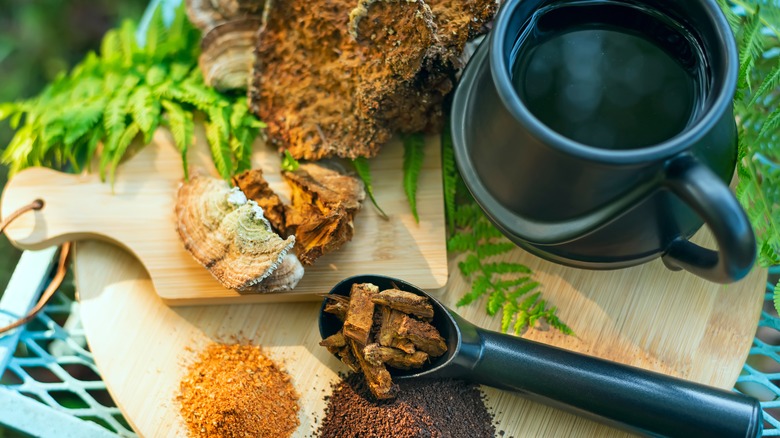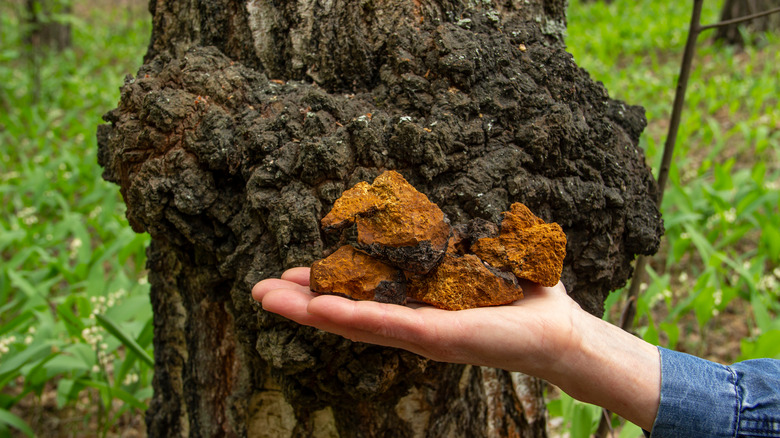The Caffeine-Free Coffee Alternative That Will Still Wake You Up
Chaga mushrooms, those brown-and-jet-colored fungi harvested from the sides of birch trees, may soon become the heir-apparent to replace your morning Joe. Teeming with the mouthfeel of coffee and a bitterness that makes it better suited for cup than plate, chaga has long been a coffee alternative, born out wartime lack and decades of folklore traditions.
But most likely, it would stand no chance as a coffee substitute if it couldn't compete against java's energy infusion. That's what makes a cup of black gold — one of the many nicknames for chaga – so coveted by most in the morning. Drinking it actually does give you enviable amounts of energy but without the jolt and the upset stomach, which is one of the reasons why so many people are willing to give it a second look.
Additionally, modern production methods have made mushroom coffee as easy to make as your favorite roasted brew. Many chaga coffee brands work just like coffee grounds do in your java maker or French press, with a filter and some water, or with just some water in the latter case. Instant chaga exists as well, and as you've probably guessed, it works just like instant coffee does. Drop some of the powdered stuff into your mug of choice, add piping hot water, maybe a smidgeon of cream, and stir.
A short history of chaga mushrooms
As with most human discoveries, chaga counts among those things where the everything-old-is-new-again mentality applies. Modern users claim it's the next superfood, citing contents like amino acids, antioxidants, vitamins, minerals, and all the things as reasons for their love affair with it. However, it's been a favorite of indigenous peoples and foragers for centuries, from North America to Asia and Europe, including Russia. Tsar Valdimir Monomakh is said to have cured lip cancer in the 12th century thanks to the medicinal properties of chaga, (per BBC). By the 16th century, medical tomes claimed it not only healed cancer but tuberculosis and ulcers, too.
The mushroom's propensity for cold weather makes it only available in the Northern climes, and in places like Alaska, where temps drop down to -40 degrees Fahrenheit, it thrives. Given its medicinal properties, it's no wonder that Native Americans in that region claim it's part of their natural pharmacy, according to the BBC.
And when coffee and sugar rations began drying up during World War II, the people of Finland turned to chaga to fill their empty coffee cups and to replace the energy they got from coffee. When the Finnish brand, Four Sigmatic, started turning out a modern version of chaga java, the brand's founder, Tero Isokauppila, tapped the coffee alternative that his grandparents had used during the war, bringing the tradition into the 21st century, (per Facebook).
Mushroom coffee blends
While chaga certainly has the color and bitterness to rival coffee on its own, many brands that produce chaga coffee, including Four Sigmatic, rely on blends to create their version of the perfect morning cup. Aside from chaga mushrooms, the brand's coffee alternative might also include ashwaganda, lion's mane mushrooms, rodiola, and other natural ingredients. Chagaccino, made by Renude, has been touted as "mushroom mocha," and unsurprisingly, perhaps, contains cacao, ceylon, cinnamon, and monk fruit sweetener to make it taste good and chocolatey. While it may not yet rival other flavored coffee brands' extensive line-ups, it's off to a good start.
However, not all mushroom coffee blends opt out of the java experience entirely. LOKO Nature's Tiger 2 Mushroom Coffee Lion's Mane + Chaga, for example, includes both beans and 'shrooms — lion's mane and chaga, to be exact — as well as arabica coffee. In the case of coffee/mushroom hybrids, the coffee still has some caffeine, but because it's blended with other ingredients, there's less caffeine per perk, so to speak. Instead, the brands also rely on the power of mushrooms to provide drinkers with the energy they need to push through their day.


